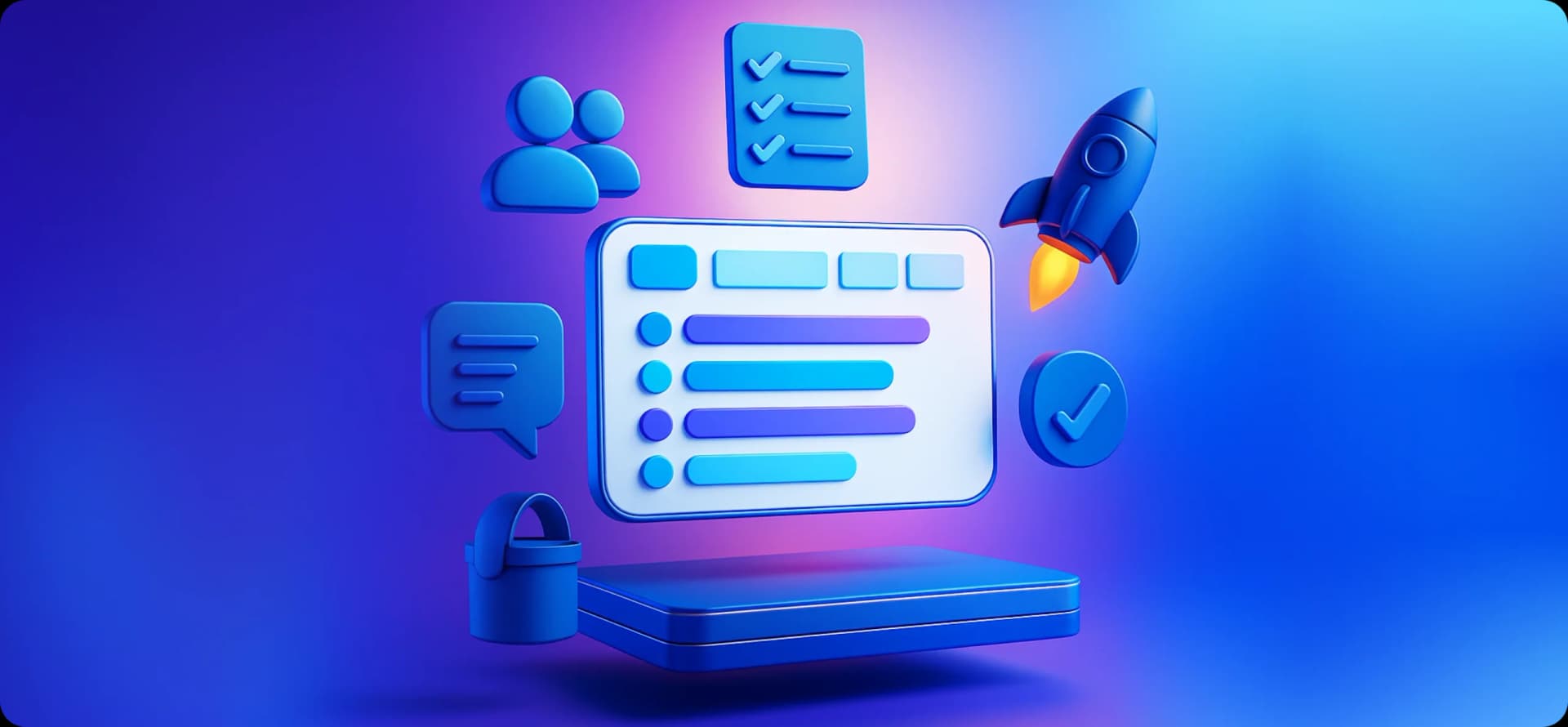Implementing new painting contractor software can feel overwhelming, but with the right approach, you can ensure a smooth transition that your entire team will embrace.
Many painting business owners worry about disrupting their daily operations or facing resistance from long-time employees who are comfortable with current processes.
The truth is that thousands of painting contractors have successfully made this transition by using a systematic approach that minimizes disruption while maximizing benefits. Whether you’re moving from paper-based systems, basic spreadsheets, or outdated software, this guide provides practical, field-tested guidance from real contractor experiences.
We’ll guide you through a systematic six-phase approach that encompasses everything from initial planning to long-term optimization.
By following this guide, you’ll have a clear roadmap from initial planning through successful deployment and beyond. This ensures your investment in technology pays dividends for years to come.
Thinking about FieldCamp for your Painting Business?
While this guide covers general software implementation best practices, FieldCamp is designed to be easier and faster to implement than traditional software rollouts. Learn more about implementing FieldCamp in your painting business here.
Want to explore this visually? Have a look at our video.
A) Pre-Implementation Planning
Implementation team formation and roles
Success starts with assembling the right team before you begin the technical aspects.
Your project champion should be someone with authority to make decisions, often the owner or operations manager, who can remove obstacles and keep the project moving forward.
Key team members:
- Office/Accounting Staff: Oversees financial integrations and invoicing
- Project Champion: Owner/operations manager with decision-making authority
- Estimating Representative: Handles pricing setup and proposal workflows
- Field Operations Lead: Manages mobile features and crew training
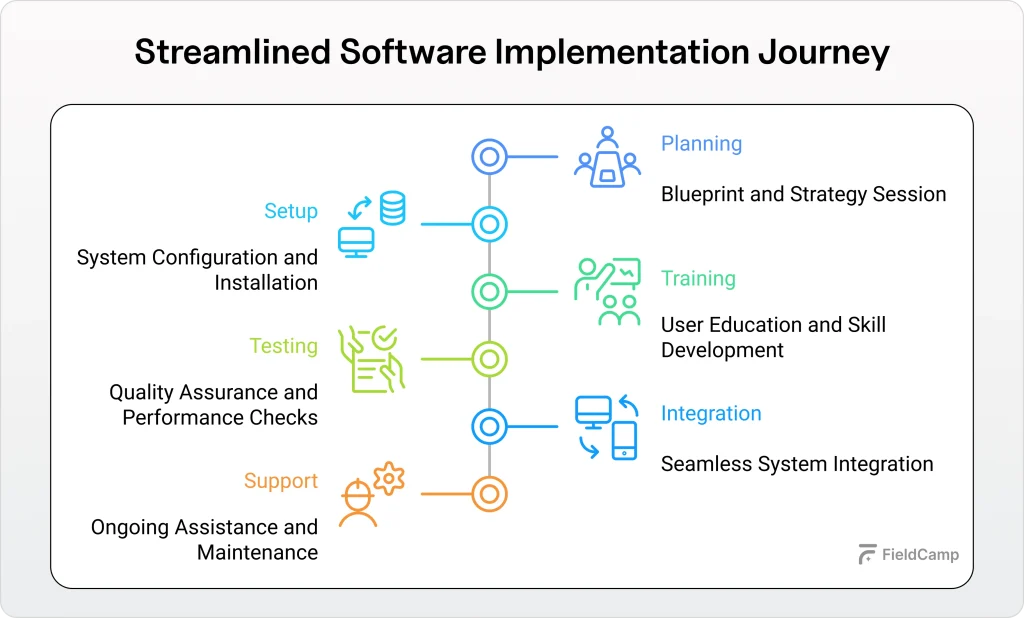
Each team member should have clearly defined responsibilities. Create communication protocols for regular updates through weekly check-in meetings during implementation.
If you’re still deciding whether making this shift is worth it, here are the real benefits of using painting contractor software that contractors have seen in their daily operations.
Current process documentation and analysis
Before changing anything, map your existing workflow from initial lead contact through final payment collection:
Essential documentation areas:
- Lead capture and qualification processes
- Estimate creation and delivery methods: Tools like estimate management ensure no quote gets forgotten.
- Job scheduling and crew assignment: Solutions like FieldCamp’s job scheduling software make this seamless.
- Material ordering and tracking procedures
- Invoice generation and payment collection
Identify current pain points that software should address:
- Are estimates taking too long to create?
- Do team members struggle with unclear job instructions?
- Is invoice collection inconsistent?
These pain points become your success metrics for measuring improvement.
Not sure if this type of solution is right for you? Check out our guide on who should use painting contractor software to see if it fits your business stage and crew size.
Data migration planning and preparation
Data migration planning is critical for success. Start by auditing all existing customer data sources:
Data sources to review:
- Excel spreadsheets and customer lists
- Paper business cards and contact forms
- Old CRM or software databases
- Email contact lists and phone contacts
- Accounting software customer records
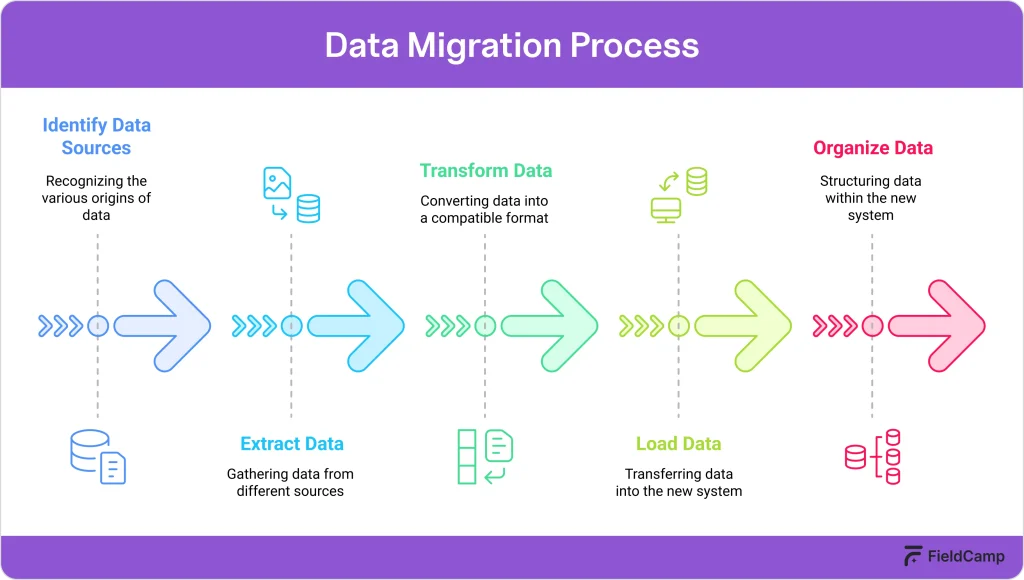
Data cleanup process:
- Remove duplicates: Same customers with multiple entries
- Update information: Verify current phone numbers and addresses
- Standardize formatting: Consistent phone numbers and address formats
Organize project history by status: active jobs, completed projects, and archived work. Create comprehensive backups before beginning any migration process.
Timeline and milestone establishment
Set realistic implementation phases (typically 2-8 weeks) with buffer time for unexpected challenges:
Sample timeline:
- Weeks 1-2: Team formation and data cleanup
- Weeks 3-4: System setup and initial training
- Weeks 5-6: Pilot testing and refinement
- Week 7+: Full deployment and optimization
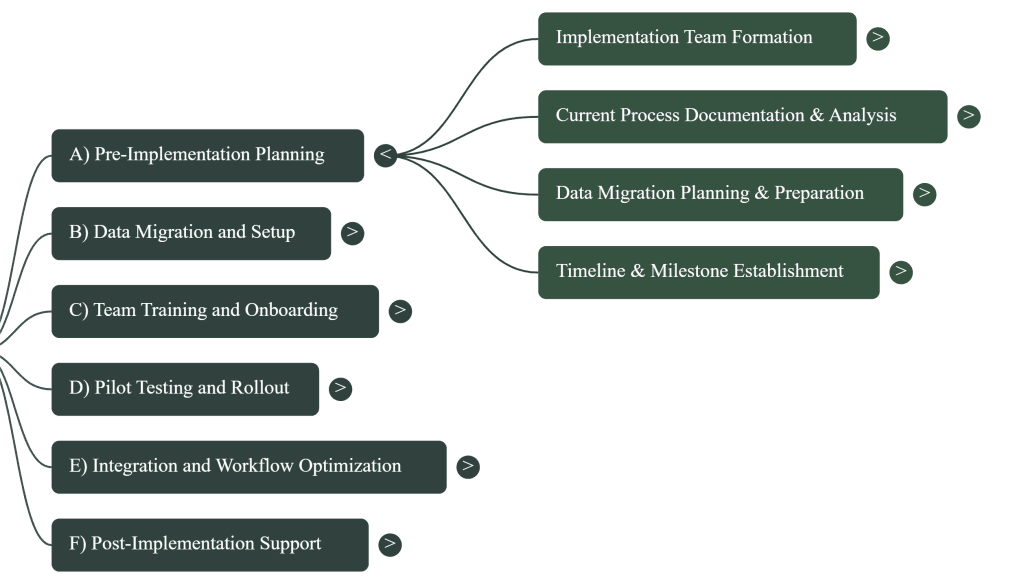
B) Data Migration and Setup
Customer and contact information transfer
Start by exporting existing customer lists from all current systems.
Format data according to your new software’s requirements; most systems provide import templates specifying required fields and formatting.
Import best practices:
- Always test imports in a staging environment first
- Clean duplicate entries before importing
- Verify contact information accuracy
- Maintain detailed migration logs
Historical project and financial data import
Prioritize which historical data needs importing versus what can remain in legacy systems:
Import priorities:
- High priority: Active projects, outstanding invoices, warranty obligations
- Medium priority: Recent completions (last 12 months), customer payment history
- Low priority: Archived projects for reference only
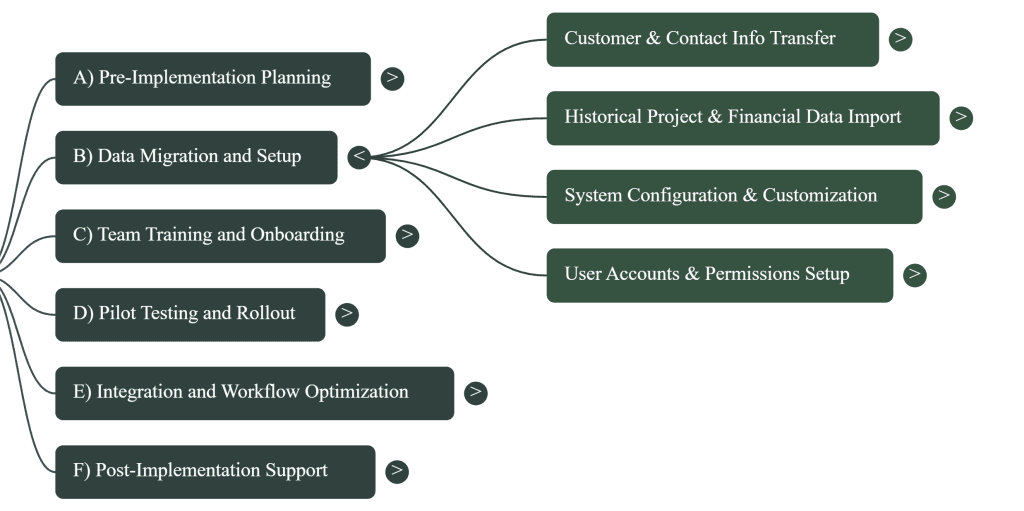
System configuration and customization
Configure essential elements for a professional presentation:
Branding setup:
- Company logo and color scheme
- Professional document templates
- Email signatures and communication templates
Service configuration:
- Residential interior ($3.50-4.50/sq ft)
- Residential exterior ($2.80-3.80/sq ft)
- Light commercial ($2.20-3.20/sq ft)
- Specialty services (premium rates)
User accounts and permissions setup
Create individual accounts with role-based permissions:
Access levels:
- Admin: Full system access and configuration
- Manager: Scheduling, reporting, customer management
- Estimator: Customer info, pricing, proposal creation
- Field Crew: Mobile app, time tracking, photo upload
C) Team Training and Onboarding
Administrator and manager training sessions
Begin with platform basics before advanced features:
Training modules:
- System Navigation (2 hours): Login, dashboard, basic settings
- Customer Management (2 hours): Adding customers, communication tools
- Estimating & Proposals (3 hours): Template creation, pricing, delivery
- Financial Management (2 hours): Invoicing, payment tracking, reporting
Practice with real examples from your business rather than generic scenarios.
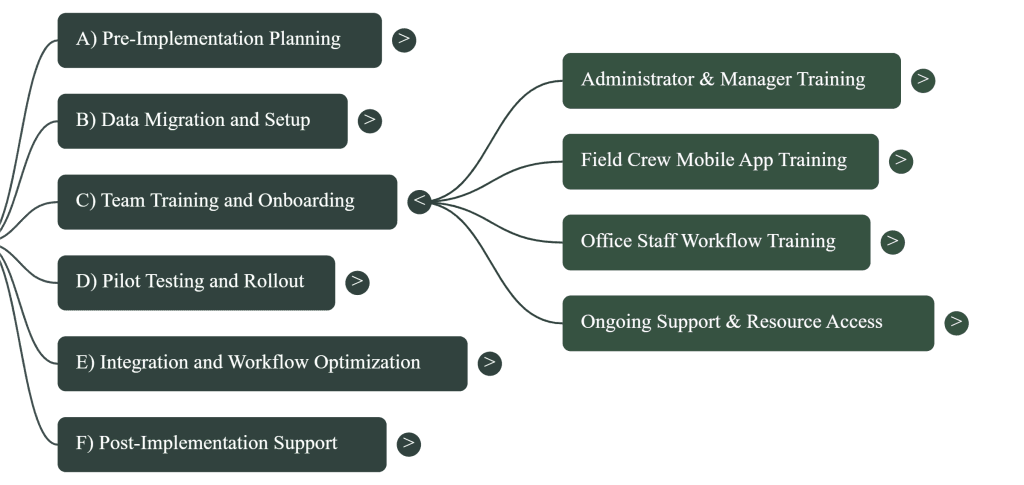
Field crew mobile app training
Schedule convenient training sessions for training for painters focused on mobile functionality:
Mobile training essentials:
- App download and login procedures
- Time tracking and job status updates
- Photo upload and customer signatures
- Communication with the office and customers
Create quick reference cards for job sites during the onboarding process.
Office staff workflow training
Map new digital workflows to replace paper processes:
Key workflow changes:
- Estimates: From manual calculations to automated templates
- Scheduling: From wall calendars to digital coordination
- Communication: From phone calls to automated messaging
- Invoicing: From manual creation to automated generation. (FieldCamp’s invoicing & payments make billing consistent and professional)
Wish to test the waters before diving in? Check out FieldCamp’s painting invoice template to get the gist.
Ongoing support and resource access
- Designate internal software champions for peer support
- Create a shared knowledge base with tips and tricks
- Schedule regular refresher training sessions
- Establish clear help procedures for technical issues
For a clearer picture of what happens behind the scenes, here’s a simple breakdown of how painting contractor software works.
D) Pilot Testing and Rollout
Small-scale pilot project testing
Select 3-5 diverse projects representing your typical work variety:
- Small residential (1-2 days)
- Medium residential (3-5 days)
- Commercial projects
- Mix of new and repeat customers
Choose enthusiastic early adopters who can provide constructive feedback.
Issue identification and resolution
Create multiple feedback channels:
Feedback collection methods:
- Daily check-in surveys (1-2 questions)
- Weekly team meetings with structured agendas
- Anonymous suggestion systems
- One-on-one interviews with key users
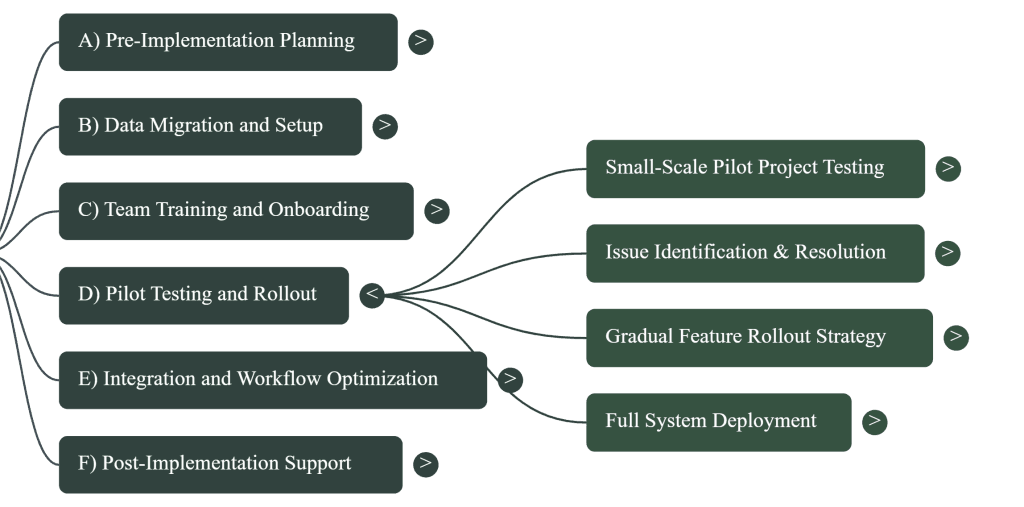
Issue priority levels:
- Critical: System down (immediate response)
- High: Blocking daily work (4-hour response)
- Medium: Workaround available (24-hour response)
- Low: Minor inconvenience (next update)
Gradual feature rollout strategy
Introduce features systematically:
Rollout phases:
- Core Features: Customer management, basic estimating, scheduling
- Communication: Email integration, notifications, mobile messaging
- Advanced Features: Automation, custom reporting, integrations
- Optimization: Custom fields, advanced automation
Full system deployment
Announce the go-live date with comprehensive preparation:
- Final data backups and system testing
- Staff schedules adjusted for additional support
- Customer communications about any changes
- Emergency procedures for critical problems
Want a full roadmap of best practices? Here’s a detailed guide on how to implement painting contractor software.
E) Integration and Workflow Optimization
Third-party software connections
Connect essential business systems:
Priority integrations:
- Accounting Software: QuickBooks, Xero, FreshBooks
- Payment Processing: Square, Stripe, PayPal
- Email Marketing: Mailchimp, Constant Contact
- Supplier Systems: Material catalogs and pricing feeds
Test all integrations thoroughly before relying on them for critical processes.
Process refinement and optimization
Review workflows after initial implementation:
- Identify bottlenecks and unnecessary steps
- Streamline approval processes
- Eliminate duplicate data entry
- Optimize for mobile-first field operations
Using checklists & forms helps crews avoid missed steps.
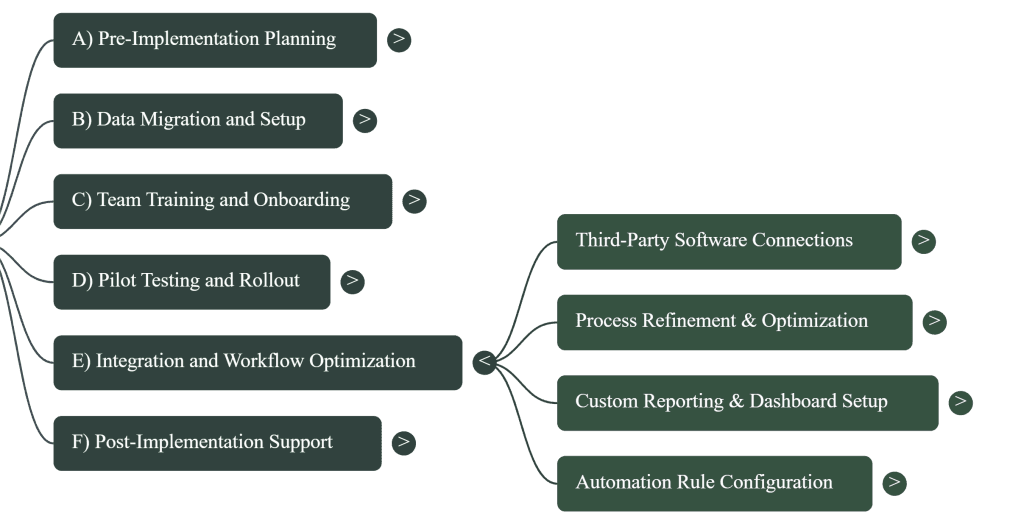
Custom reporting and dashboard setup
Configure dashboards for different roles:
- Owners: Financial metrics, strategic overview
- Managers: Operational efficiency, team performance
- Estimators: Sales pipeline, conversion rates
- Field Supervisors: Job progress, crew management
Automation rule configuration
Set up key automations:
- Estimate Follow-ups: Automatic reminders at 24 hours, 1 week, 2 weeks
- Customer Notifications: Job scheduled, work started, completion
- Payment Reminders: Professional sequences for overdue accounts
- Review Requests: Automated requests 2-3 days after completion
If you’re just starting your journey, here’s a step-by-step guide on getting started with painting contractor software, and if automation is your main priority, here’s a closer look at workflow automation for painting contractors.
F) Post-Implementation Support
Performance monitoring and evaluation
Track system usage and improvements:
Key metrics:
- User adoption rates and feature utilization
- Process efficiency gains (50% faster estimates, 75% faster invoicing)
- Customer satisfaction improvements
- Financial performance (cash flow, collection times)
Compare results to pre-implementation baseline measurements.
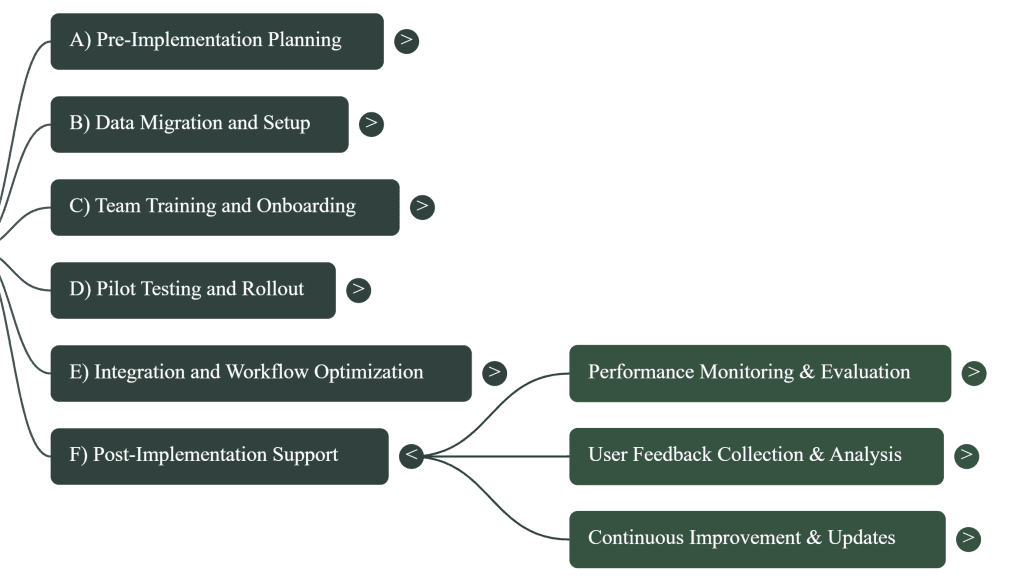
User feedback collection and analysis
Maintain ongoing communication:
- Monthly team meetings for system feedback
- Quarterly individual check-ins
- Anonymous suggestion systems
- Act promptly on feedback to demonstrate commitment
Continuous improvement and updates
- Stay informed about new features from your software provider
- Evaluate updates for business value and implementation complexity
- Plan systematic rollouts for significant updates
- Maintain regular training schedules
With dispatch scheduling, you can keep operations smooth even as your business scales.
Making It Happen
Successful painting contractor software implementation is absolutely achievable with proper planning and systematic execution. While the process requires investment in time and effort, the long-term benefits in efficiency, customer satisfaction, and business growth far outweigh temporary disruption.
Start with small, manageable steps rather than waiting for perfect conditions. The transformation from manual processes to integrated software systems positions your business for sustained growth and competitive advantage. With this systematic approach, you’ll minimize risks while maximizing your technology investment return..
Your Best Business Years Are Slipping Away
Every day you spend buried in admin work is a day you’re not mastering your craft or building wealth. Time doesn’t wait. Your potential doesn’t pause. With FieldCamp, the hardest part is deciding to start.
Frequently Asked Questions
How long does it take to implement painting contractor software?
Most painting contractors complete implementation in 2-8 weeks. The onboarding process includes data migration, team training, and pilot testing before full deployment.
Do I need painting-specific contractor software, or can I use generic field service software?
Painting-specific software includes pre-built estimating templates, material catalogs, and industry workflows. Generic software requires extensive customization, increasing setup time and costs significantly.
How do I train employees who are not tech-savvy?
Start with mobile basics: clock in/out, photos, job updates. Use hands-on training for painters with simple reference cards and peer mentoring for best results.
What data should I migrate when switching to new painting contractor software?
Prioritize active customers, current projects, outstanding invoices, and warranty obligations. Historical data older than 12 months can remain in your previous system.
What if my current data is messy or incomplete? Can it still be migrated?
Yes. Clean critical customer data first, migrate gradually, and update incomplete records during regular business operations. Perfect data isn’t required to start benefiting.
Which integrations should I set up first for the most benefit?
Connect accounting software (QuickBooks), payment processing (Square/Stripe), and email first. These eliminate duplicate data entry and provide immediate time savings and improved cash flow.
